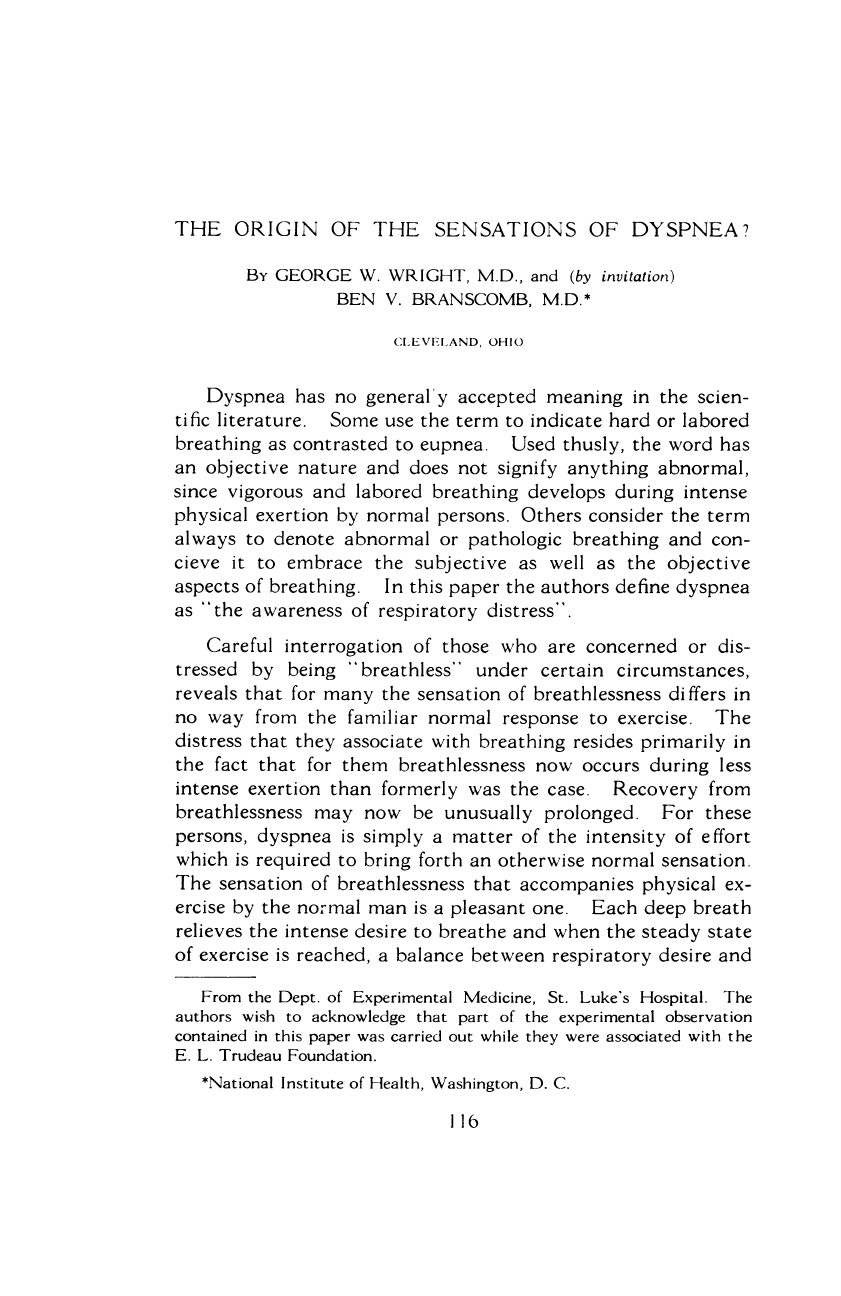
THE
ORIGIN
OF
THE
SENSATIONS
OF
DYSPNEA?
BY
GEORGE
W.
WRIGHT,
M.D.,
and
(by
invitation)
BEN
V.
BRANSCOMB,
M.D.*
C
LEVI
lAND,
OHIO
Dyspnea
has
no
general'y
accepted
meaning
in
the
scien-
tific
literature.
Some
use
the
term
to
indicate
hard
or
labored
breathing
as
contrasted
to
eupnea.
Used
thusly,
the
word
has
an
objective
nature
and
does
not
signify
anything
abnormal,
since
vigorous
and
labored
breathing
develops
during
intense
physical
exertion
by
normal
persons.
Others
consider
the
term
always
to
denote
abnormal
or
pathologic
breathing
and
con-
cieve
it
to
embrace
the
subjective
as
well
as
the
objective
aspects
of
breathing.
In
this
paper
the
authors
define
dyspnea
as
"the
awareness
of
respiratory
distress".
Careful
interrogation
of
those
who
are
concerned
or
dis-
tressed
by
being
"breathless"
under
certain
circumstances,
reveals
that
for
many
the
sensation
of
breathlessness
differs
in
no
way
from
the
familiar
normal
response
to
exercise.
The
distress
that
they
associate
with
breathing
resides
primarily
in
the
fact
that
for
them
breathlessness
now
occurs
during
less
intense
exertion
than
formerly
was
the
case.
Recovery
from
breathlessness
may
now
be
unusually
prolonged.
For
these
persons,
dyspnea
is
simply
a
matter
of
the
intensity
of
effort
which
is
required
to
bring
forth
an
otherwise
normal
sensation.
The
sensation
of
breathlessness
that
accompanies
physical
ex-
ercise
by
the
normal
man
is
a
pleasant
one.
Each
deep
breath
relieves
the
intense
desire
to
breathe
and
when
the
steady
state
of
exercise
is
reached,
a
balance
between
respiratory
desire
and
From
the
Dept.
of
Experimental
Medicine,
St.
Luke's
Hospital.
The
authors
wish
to
acknowledge
that
part
of
the
experimental
observation
contained
in
this
paper
was
carried
out
while
they
were
associated
with
the
E.
L.
Trudeau
Foundation.
*National
Institute
of
Health,
Washington,
D.
C.
116
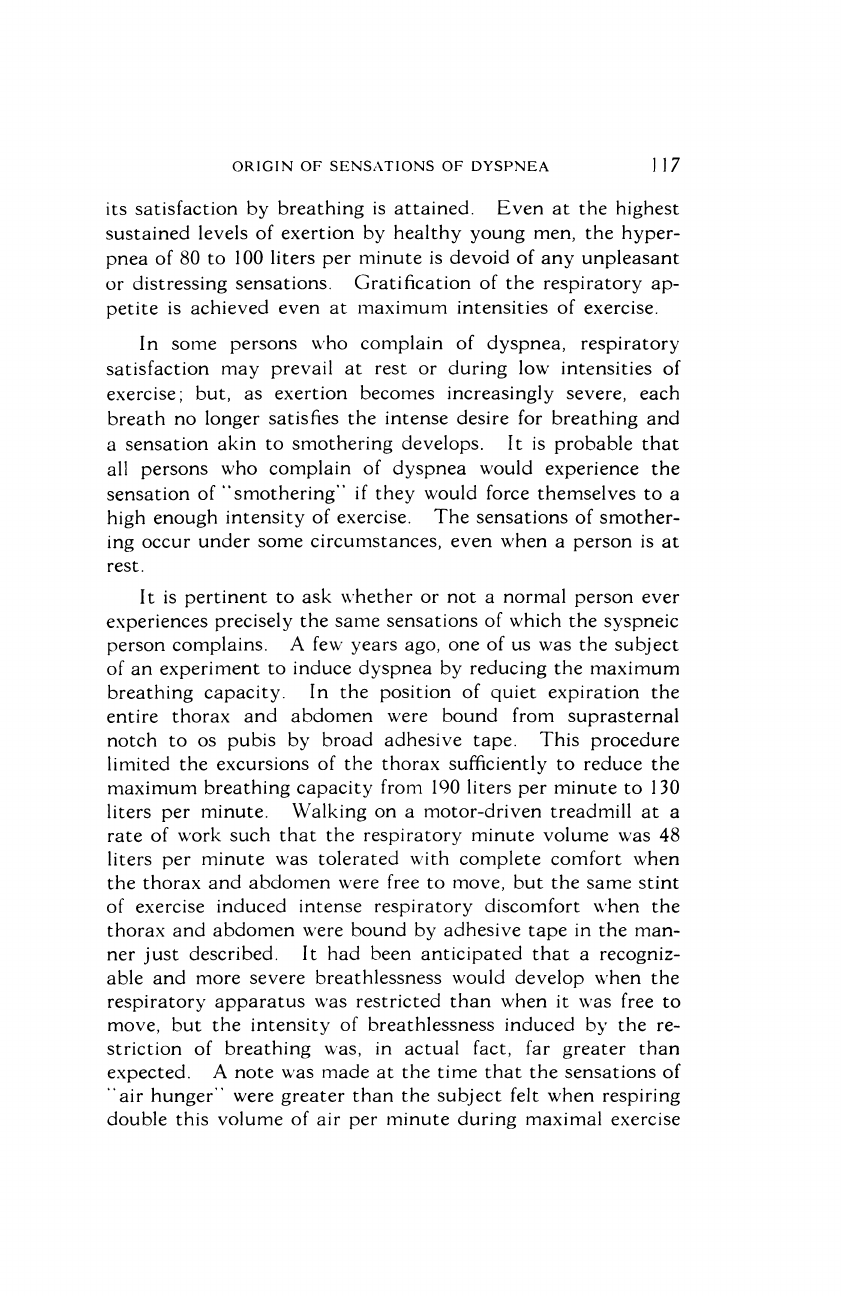
ORIGIN
OF
SENSATIONS
OF
DYSPNEA
its
satisfaction
by
breathing
is
attained.
Even
at
the
highest
sustained
levels
of
exertion
by
healthy
young
men,
the
hyper-
pnea
of
80
to
100
liters
per
minute
is
devoid
of
any
unpleasant
or
distressing
sensations.
Gratification
of
the
respiratory
ap-
petite
is
achieved
even
at
maximum
intensities
of
exercise.
In
some
persons
who
complain
of
dyspnea,
respiratory
satisfaction
may
prevail
at
rest
or
during
low
intensities
of
exercise; but,
as
exertion
becomes
increasingly
severe,
each
breath
no
longer
satisfies
the
intense
desire
for
breathing
and
a
sensation
akin
to
smothering
develops.
It
is
probable
that
all
persons
who
complain
of
dyspnea
would
experience
the
sensation
of
"smothering"
if
they
would
force
themselves
to
a
high
enough
intensity
of
exercise.
The
sensations
of
smother-
ing
occur
under
some
circumstances,
even
when
a
person
is
at
rest.
It
is
pertinent
to
ask
whether
or
not
a
normal
person
ever
experiences
precisely
the
same
sensations
of
which
the
syspneic
person
complains.
A
few
years
ago,
one
of
us
was
the
subject
of
an
experiment
to
induce
dyspnea
by
reducing
the
maximum
breathing
capacity.
In
the
position
of
quiet
expiration
the
entire
thorax
and
abdomen
were
bound
from
suprasternal
notch
to
os
pubis
by
broad
adhesive
tape.
This
procedure
limited
the
excursions
of
the
thorax
sufficiently
to
reduce
the
maximum
breathing
capacity
from
190
liters
per
minute
to
130
liters
per
minute.
Walking
on
a
motor-driven
treadmill
at
a
rate
of
work
such
that
the
respiratory
minute
volume
was
48
liters
per
minute
was
tolerated
with
complete
comfort
when
the
thorax
and
abdomen
were
free
to
move,
but
the
same
stint
of
exercise
induced
intense
respiratory
discomfort
when
the
thorax
and
abdomen
were
bound
by
adhesive
tape
in
the
man-
ner
just
described.
It
had
been
anticipated
that
a
recogniz-
able
and
more
severe
breathlessness
would
develop
when
the
respiratory
apparatus
was
restricted
than
when
it
was
free
to
move,
but
the
intensity
of
breathlessness
induced
by
the
re-
striction
of
breathing
was,
in
actual
fact,
far
greater
than
expected.
A
note
was
made
at
the
time
that
the
sensations
of
"air
hunger"
were
greater
than
the
subject
felt
when
respiring
double
this
volume
of
air
per
minute
during
maximal
exercise
11l7
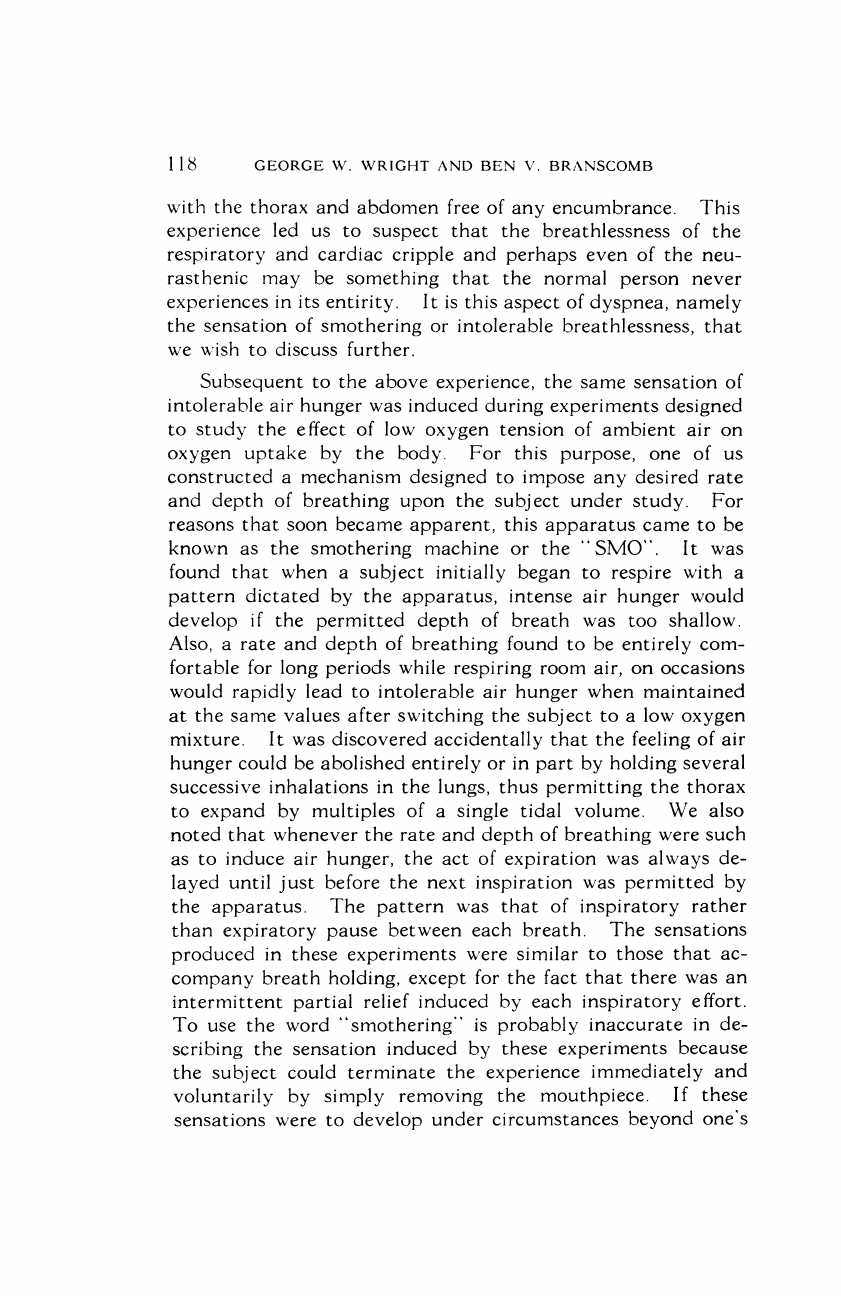
1
18
GEORGE
W.
WRIGHT
AND
BEN
V.
BRANSCOMB
with
the
thorax
and
abdomen
free
of
any
encumbrance.
This
experience
led
us
to
suspect
that
the
breathlessness
of
the
respiratory
and
cardiac
cripple
and
perhaps
even
of
the
neu-
rasthenic
may
be
something
that
the
normal
person
never
experiences
in
its
entirity.
It
is
this
aspect
of
dyspnea,
namely
the
sensation
of
smothering
or
intolerable
breathlessness,
that
we
wish
to
discuss
further.
Subsequent
to
the
above
experience,
the
same
sensation
of
intolerable
air
hunger
was
induced
during
experiments
designed
to
study
the
effect
of
low
oxygen
tension
of
ambient
air
on
oxygen
uptake
by
the
body.
For
this
purpose,
one
of
us
constructed
a
mechanism
designed
to
impose
any
desired
rate
and
depth
of
breathing
upon
the
subject
under
study.
For
reasons
that
soon
became
apparent,
this
apparatus
came
to
be
known
as
the
smothering
machine
or
the
'SMO".
It
was
found
that
when
a
subject
initially
began
to
respire
with
a
pattern
dictated
by
the
apparatus,
intense
air
hunger
would
develop
if
the
permitted
depth
of
breath
was
too
shallow.
Also,
a
rate
and
depth
of
breathing
found
to
be
entirely
com-
fortable
for
long
periods
while
respiring
room
air,
on
occasions
would
rapidly
lead
to
intolerable
air
hunger
when
maintained
at
the
same
values
after
switching
the
subject
to a
low
oxygen
mixture.
It
was
discovered
accidentally
that
the
feeling
of
air
hunger
could
be
abolished
entirely
or
in
part
by
holding
several
successive
inhalations
in
the
lungs,
thus
permitting
the
thorax
to
expand
by
multiples
of
a
single
tidal
volume.
We
also
noted
that
whenever
the
rate
and
depth
of
breathing
were
such
as
to
induce
air
hunger,
the
act
of
expiration
was
always
de-
layed
until
just
before
the
next
inspiration
was
permitted
by
the
apparatus.
The
pattern
was
that
of
inspiratory
rather
than
expiratory
pause
between
each
breath.
The
sensations
produced
in
these
experiments
were
similar
to
those
that
ac-
company
breath
holding,
except
for
the
fact
that
there
was
an
intermittent
partial
relief
induced
by
each
inspiratory
effort.
To
use
the
word
"smothering"
is
probably
inaccurate
in
de-
scribing
the
sensation
induced
by
these
experiments
because
the
subject
could
terminate
the
experience
immediately
and
voluntarily
by
simply
removing
the
mouthpiece.
If
these
sensations
were
to
develop
under
circumstances
beyond
one's
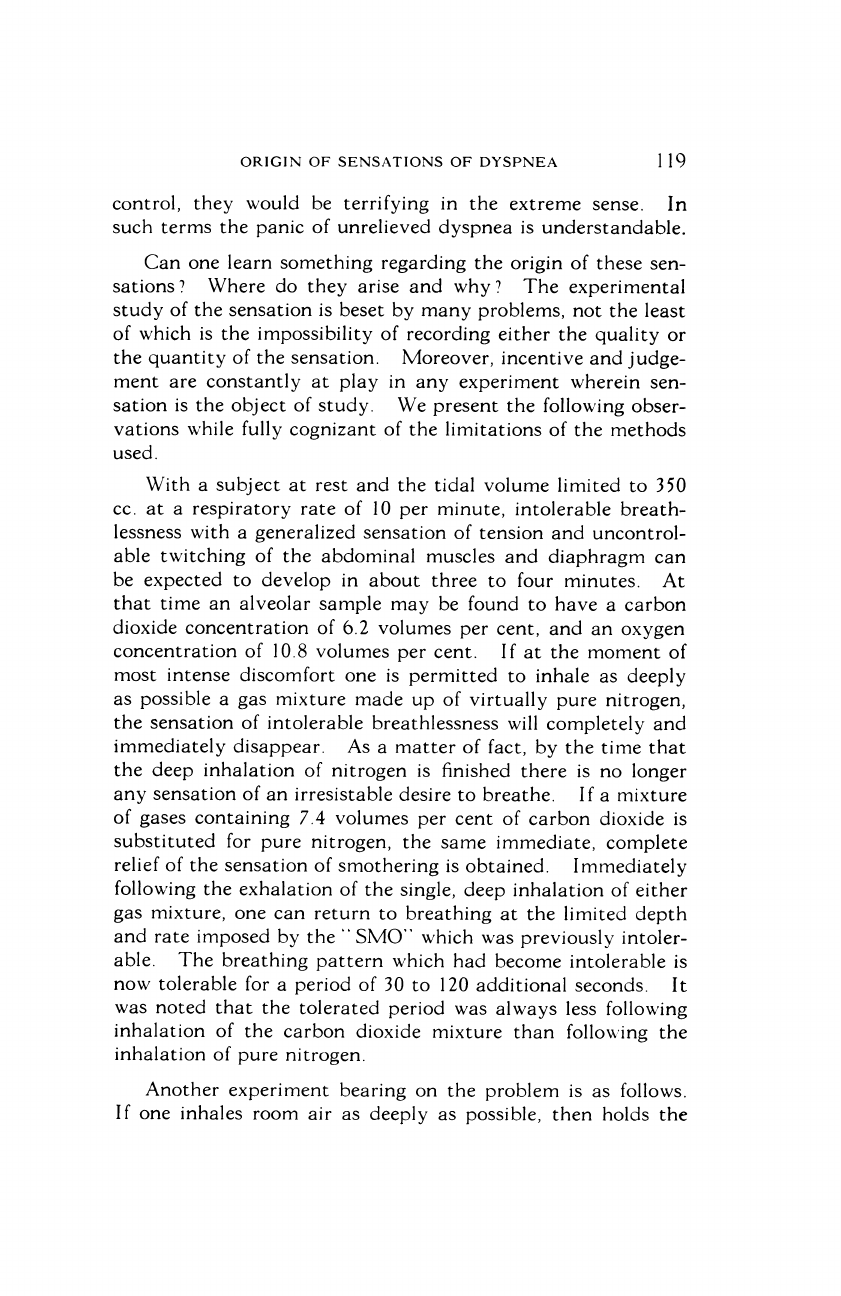
ORIGIN
OF
SENSATIONS
OF
DYSPNEA
control,
they
would
be
terrifying
in
the
extreme
sense.
In
such
terms
the
panic
of
unrelieved
dyspnea
is
understandable.
Can
one
learn
something
regarding
the
origin
of
these
sen-
sations?
Where
do
they
arise
and
why?
The
experimental
study
of
the
sensation
is
beset
by
many
problems,
not
the
least
of
which
is
the
impossibility
of
recording
either
the
quality
or
the
quantity
of
the
sensation.
Moreover,
incentive
and
judge-
ment
are
constantly
at
play
in
any
experiment
wherein
sen-
sation
is
the
object
of
study.
We
present
the
following
obser-
vations
while
fully
cognizant
of
the
limitations
of
the
methods
used.
With
a
subject
at
rest
and
the
tidal
volume
limited
to
350
cc.
at
a
respiratory
rate
of
10
per
minute,
intolerable
breath-
lessness
with
a
generalized
sensation
of
tension
and
uncontrol-
able
twitching
of
the
abdominal
muscles
and
diaphragm
can
be
expected
to
develop
in
about
three
to
four
minutes.
At
that
time
an
alveolar
sample
may
be
found
to
have
a
carbon
dioxide
concentration
of
6.2
volumes
per
cent,
and
an
oxygen
concentration
of
10.8
volumes
per
cent.
If
at
the
moment
of
most
intense
discomfort
one
is
permitted
to
inhale
as
deeply
as
possible
a
gas
mixture
made
up
of
virtually
pure
nitrogen,
the
sensation
of
intolerable
breathlessness
will
completely
and
immediately
disappear.
As
a
matter
of
fact,
by
the
time
that
the
deep
inhalation
of
nitrogen
is
finished
there
is
no
longer
any
sensation
of
an
irresistable
desire
to
breathe.
If
a
mixture
of
gases
containing
7.4
volumes
per
cent
of
carbon
dioxide
is
substituted
for
pure
nitrogen,
the
same
immediate,
complete
relief
of
the
sensation
of
smothering
is
obtained.
Immediately
following
the
exhalation
of
the
single,
deep
inhalation
of
either
gas
mixture,
one
can
return
to
breathing
at
the
limited
depth
and
rate
imposed
by
the
'
SMO"
which
was
previously
intoler-
able.
The
breathing
pattern
which
had
become
intolerable
is
now
tolerable
for
a
period
of
30
to
120
additional
seconds.
It
was
noted
that
the
tolerated
period
was
always
less
following
inhalation
of
the
carbon
dioxide
mixture
than
following
the
inhalation
of
pure
nitrogen.
Another
experiment
bearing
on
the
problem
is
as
follows.
If
one
inhales
room
air
as
deeply
as
possible,
then
holds
the
119
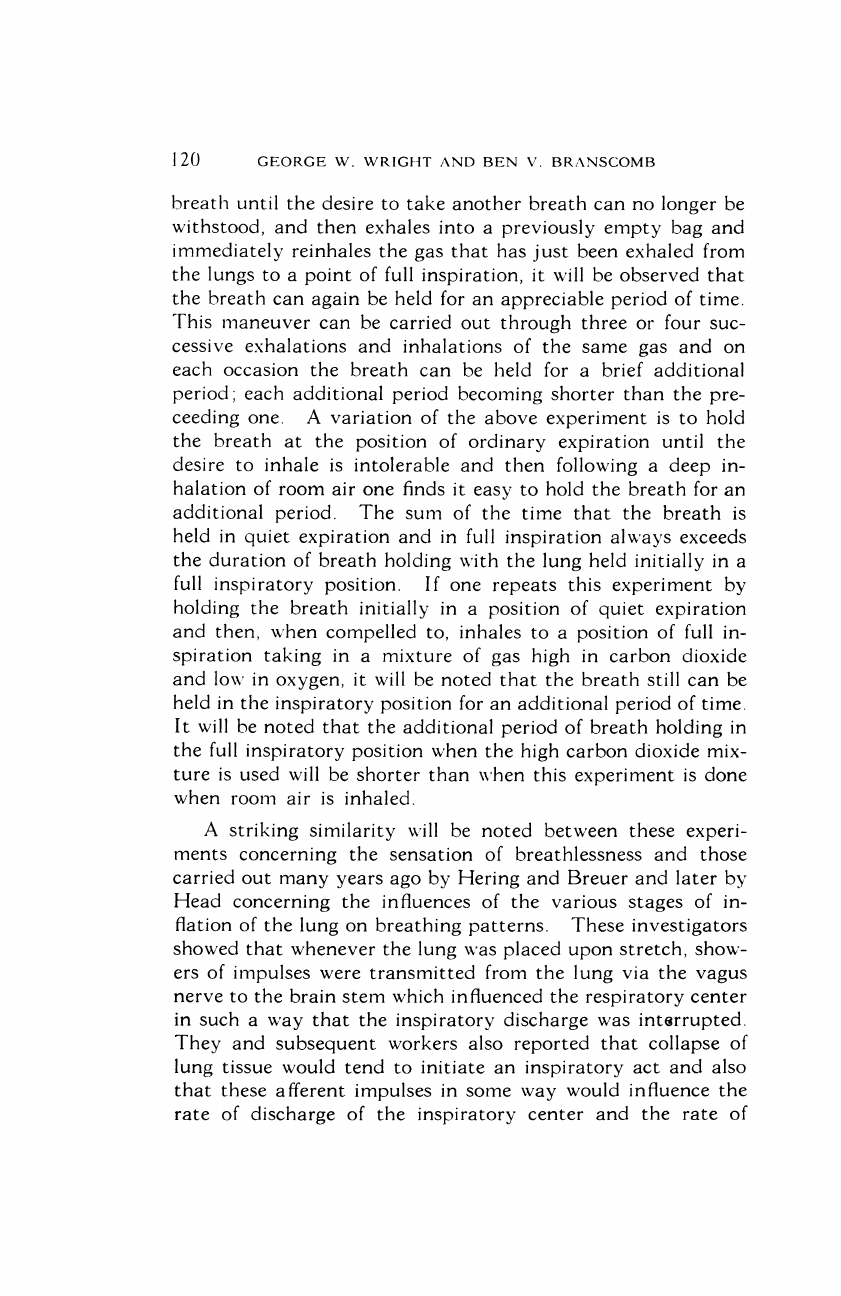
120
GEORGE
W.
WRIGHT
AND
BEN
V.
BRANSCOMB
breath
until
the
desire
to
take
another
breath
can
no
longer
be
withstood,
and
then
exhales
into
a
previously
empty
bag
and
immediately
reinhales
the
gas
that
has
just
been
exhaled
from
the
lungs
to
a
point
of
full
inspiration,
it
will
be
observed
that
the
breath
can
again
be
held
for
an
appreciable
period
of
time.
This
maneuver
can
be
carried
out
through
three
or
four
suc-
cessive
exhalations
and
inhalations
of
the
same
gas
and
on
each
occasion
the
breath
can
be
held
for
a
brief
additional
period;
each
additional
period
becoming
shorter
than
the
pre-
ceeding
one.
A
variation
of
the
above
experiment
is
to
hold
the
breath
at
the
position
of
ordinary
expiration
until
the
desire
to
inhale
is
intolerable
and
then
following
a
deep
in-
halation
of
room
air
one
finds
it
easy
to
hold
the
breath
for
an
additional
period.
The
sum
of
the
time
that
the
breath
is
held
in
quiet
expiration
and
in
full
inspiration
always
exceeds
the
duration
of
breath
holding
with
the
lung
held
initially
in
a
full
inspiratory
position.
If
one
repeats
this
experiment
by
holding
the
breath
initially
in
a
position
of
quiet
expiration
and
then,
when
compelled
to,
inhales
to
a
position
of
full
in-
spiration
taking
in
a
mixture
of
gas
high
in
carbon
dioxide
and
low
in
oxygen,
it
will
be
noted
that
the
breath
still
can
be
held
in
the
inspiratory
position
for
an
additional
period
of
time.
It
will
be
noted
that
the
additional
period
of
breath
holding
in
the
full
inspiratory
position
when
the
high
carbon
dioxide
mix-
ture
is
used
will
be
shorter
than
when
this
experiment
is
done
when
room
air
is
inhaled.
A
striking
similarity
will
be
noted
between
these
experi-
ments
concerning
the
sensation
of
breathlessness
and
those
carried
out
many
years
ago
by
Hering
and
Breuer
and
later
by
Head
concerning
the
influences
of
the
various
stages
of
in-
flation
of
the
lung
on
breathing
patterns.
These
investigators
showed
that
whenever
the
lung
was
placed
upon
stretch,
show-
ers
of
impulses
were
transmitted
from
the
lung
via
the
vagus
nerve
to
the
brain
stem
which
influenced
the
respiratory
center
in
such
a
way
that
the
inspiratory
discharge
was
interrupted.
They
and
subsequent
workers
also
reported
that
collapse
of
lung
tissue
would
tend
to
initiate
an
inspiratory
act
and
also
that
these
afferent
impulses
in
some
way
would
influence
the
rate
of
discharge
of
the
inspiratory
center
and
the
rate
of
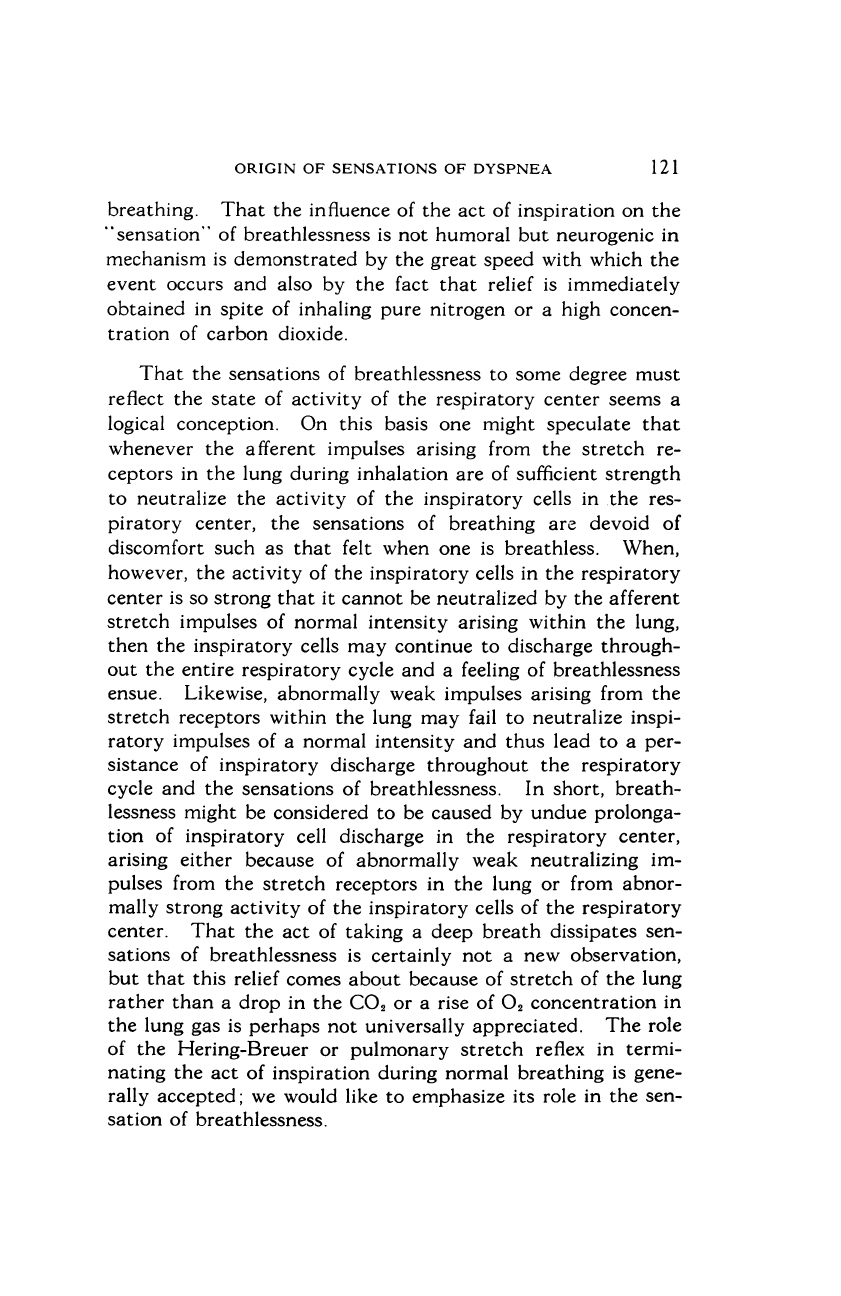
ORIGIN
OF
SENSATIONS
OF
DYSPNEA
breathing.
That
the
influence
of
the
act
of
inspiration
on
the
sensation"
of
breathlessness
is
not
humoral
but
neurogenic
in
mechanism
is
demonstrated
by
the
great
speed
with
which
the
event
occurs
and
also
by
the
fact
that
relief
is
immediately
obtained
in
spite
of
inhaling
pure
nitrogen
or a
high
concen-
tration
of
carbon
dioxide.
That
the
sensations
of
breathlessness
to
some
degree
must
reflect
the
state
of
activity
of
the
respiratory
center
seems
a
logical
conception.
On
this
basis
one
might
speculate
that
whenever
the
a
fferent
impulses
arising
from
the
stretch
re-
ceptors
in
the
lung
during
inhalation
are
of
sufficient
strength
to
neutralize
the
activity
of
the
inspiratory
cells
in
the
res-
piratory
center,
the
sensations
of
breathing
are
devoid
of
discomfort
such
as
that
felt
when
one
is
breathless.
When,
however,
the
activity
of
the
inspiratory
cells
in
the
respiratory
center
is
so
strong
that
it
cannot
be
neutralized
by
the
afferent
stretch
impulses
of
normal
intensity
arising
within
the
lung,
then
the
inspiratory
cells
may
continue
to
discharge
through-
out
the
entire
respiratory
cycle
and
a
feeling
of
breathlessness
ensue.
Likewise,
abnormally
weak
impulses
arising
from
the
stretch
receptors
within
the
lung
may
fail
to
neutralize
inspi-
ratory
impulses
of
a
normal
intensity
and
thus
lead
to
a
per-
sistance
of
inspiratory
discharge
throughout
the
respiratory
cycle
and
the
sensations
of
breathlessness.
In
short,
breath-
lessness
might
be
considered
to
be
caused
by
undue
prolonga-
tion
of
inspiratory
cell
discharge
in
the
respiratory
center,
arising
either
because
of
abnormally
weak
neutralizing
im-
pulses
from
the
stretch
receptors
in
the
lung
or
from
abnor-
mally
strong
activity
of
the
inspiratory
cells
of
the
respiratory
center.
That
the
act
of
taking
a
deep
breath
dissipates
sen-
sations
of
breathlessness
is
certainly
not
a
new
observation,
but
that
this
relief
comes
about
because
of
stretch
of
the
lung
rather
than
a
drop
in
the
CO2
or
a
rise
of
02
concentration
in
the
lung
gas
is
perhaps
not
universally
appreciated.
The
role
of
the
Hering-Breuer
or
pulmonary
stretch
reflex
in
termi-
nating
the
act
of
inspiration
during
normal
breathing
is
gene-
rally
accepted;
we
would
like
to
emphasize
its
role
in
the
sen-
sation
of
breathlessness.
121
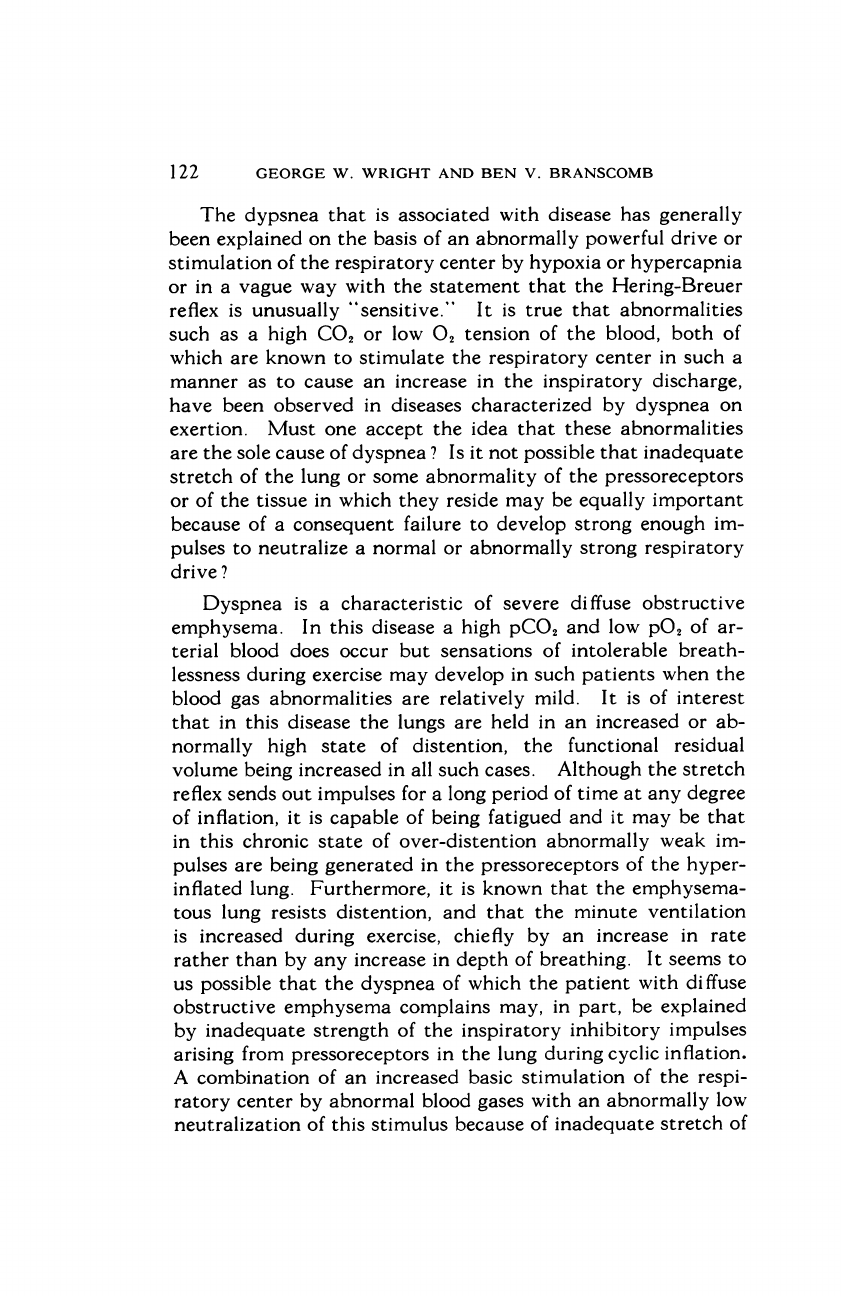
122
GEORGE
W.
WRIGHT
AND
BEN
V.
BRANSCOMB
The
dypsnea
that
is
associated
with
disease
has
generally
been
explained
on
the
basis
of
an
abnormally
powerful
drive
or
stimulation
of
the
respiratory
center
by
hypoxia
or
hypercapnia
or
in
a
vague
way
with
the
statement
that
the
Hering-Breuer
reflex
is
unusually
"sensitive."
It
is
true
that
abnormalities
such
as
a
high
CO2
or
low
02
tension
of
the
blood,
both
of
which
are
known
to
stimulate
the
respiratory
center
in
such
a
manner
as
to
cause
an
increase
in
the
inspiratory
discharge,
have
been
observed
in
diseases
characterized
by
dyspnea
on
exertion.
Must
one
accept
the
idea
that
these
abnormalities
are
the
sole
cause
of
dyspnea?
Is
it
not
possible
that
inadequate
stretch
of
the
lung
or
some
abnormality
of
the
pressoreceptors
or
of
the
tissue
in
which
they
reside
may
be
equally
important
because
of
a
consequent
failure
to
develop
strong
enough
im-
pulses
to
neutralize
a
normal
or
abnormally
strong
respiratory
drive
?
Dyspnea
is
a
characteristic
of
severe
di
ffuse
obstructive
emphysema.
In
this
disease
a
high
pCO2
and
low
pO2
of
ar-
terial
blood
does
occur
but
sensations
of
intolerable
breath-
lessness
during
exercise
may
develop
in
such
patients
when
the
blood
gas
abnormalities
are
relatively
mild.
It
is
of
interest
that
in
this
disease
the
lungs
are
held
in
an
increased
or
ab-
normally
high
state
of
distention,
the
functional
residual
volume
being
increased
in
all
such
cases.
Although
the
stretch
reflex
sends
out
impulses
for
a
long
period
of
time
at
any
degree
of
inflation,
it
is
capable
of
being
fatigued
and
it
may
be
that
in
this
chronic
state
of
over-distention
abnormally
weak
im-
pulses
are
being
generated
in
the
pressoreceptors
of
the
hyper-
inflated
lung.
Furthermore,
it
is
known
that
the
emphysema-
tous
lung
resists
distention,
and
that
the
minute
ventilation
is
increased
during
exercise,
chiefly
by
an
increase
in
rate
rather
than
by
any
increase
in
depth
of
breathing.
It
seems
to
us
possible
that
the
dyspnea
of
which
the
patient
with
diffuse
obstructive
emphysema
complains
may,
in
part,
be
explained
by
inadequate
strength
of
the
inspiratory
inhibitory
impulses
arising
from
pressoreceptors
in
the
lung
during
cyclic
inflation.
A
combination
of
an
increased
basic
stimulation
of
the
respi-
ratory
center
by
abnormal
blood
gases
with
an
abnormally
low
neutralization
of
this
stimulus
because
of
inadequate
stretch
of
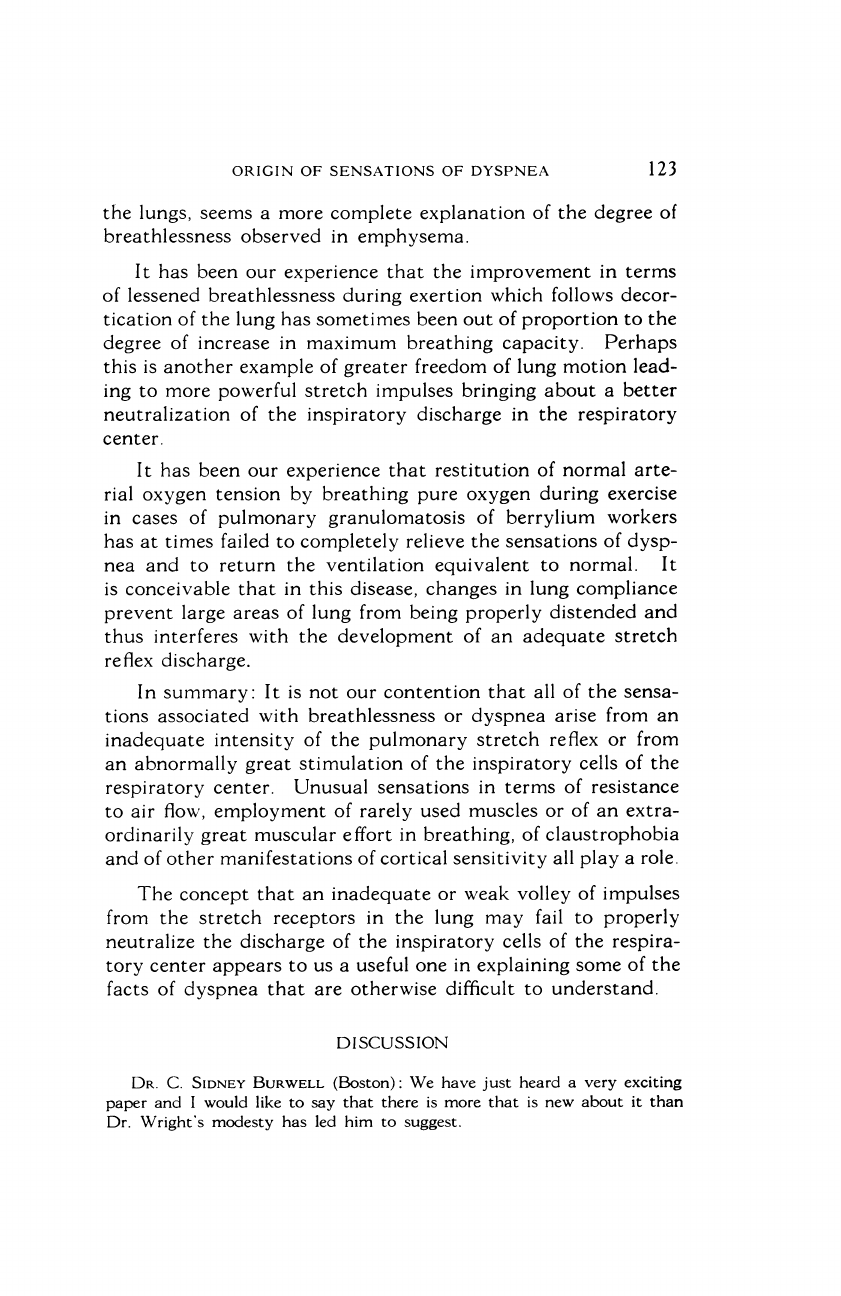
ORIGIN
OF
SENSATIONS
OF
DYSPNEA
the
lungs,
seems
a
more
complete
explanation
of
the
degree
of
breathlessness
observed
in
emphysema.
It
has
been
our
experience
that
the
improvement
in
terms
of
lessened
breathlessness
during
exertion
which
follows
decor-
tication
of
the
lung
has
sometimes
been
out
of
proportion
to
the
degree
of
increase
in
maximum
breathing
capacity.
Perhaps
this
is
another
example
of
greater
freedom
of
lung
motion
lead-
ing
to
more
powerful
stretch
impulses
bringing
about
a
better
neutralization
of
the
inspiratory
discharge
in
the
respiratory
center.
It
has
been
our
experience
that
restitution
of
normal
arte-
rial
oxygen
tension
by
breathing
pure
oxygen
during
exercise
in
cases
of
pulmonary
granulomatosis
of
berrylium
workers
has
at
times
failed
to
completely
relieve
the
sensations
of
dysp-
nea
and
to
return
the
ventilation
equivalent
to
normal.
It
is
conceivable
that
in
this
disease,
changes
in
lung
compliance
prevent
large
areas
of
lung
from
being
properly
distended
and
thus
interferes
with
the
development
of
an
adequate
stretch
reflex
discharge.
In
summary:
It
is
not
our
contention
that
all
of
the
sensa-
tions
associated
with
breathlessness
or
dyspnea
arise
from
an
inadequate
intensity
of
the
pulmonary
stretch
reflex
or
from
an
abnormally
great
stimulation
of
the
inspiratory
cells
of
the
respiratory
center.
Unusual
sensations
in
terms
of
resistance
to
air
flow,
employment
of
rarely
used
muscles
or
of
an
extra-
ordinarily
great
muscular
effort
in
breathing,
of
claustrophobia
and
of
other
manifestations
of
cortical
sensitivity
all
play
a
role.
The
concept
that
an
inadequate
or
weak
volley
of
impulses
from
the
stretch
receptors
in
the
lung
may
fail
to
properly
neutralize
the
discharge
of
the
inspiratory
cells
of
the
respira-
tory
center
appears
to
us
a
useful
one
in
explaining
some
of
the
facts
of
dyspnea
that
are
otherwise
difficult
to
understand.
DISCUSSION
DR.
C.
SIDNEY
BURWELL
(Boston):
We
have
just
heard
a
very
exciting
paper
and
I
would
like
to
say
that
there
is
more
that
is
new
about
it
than
Dr.
Wright's
modesty
has
led
him
to
suggest.
123
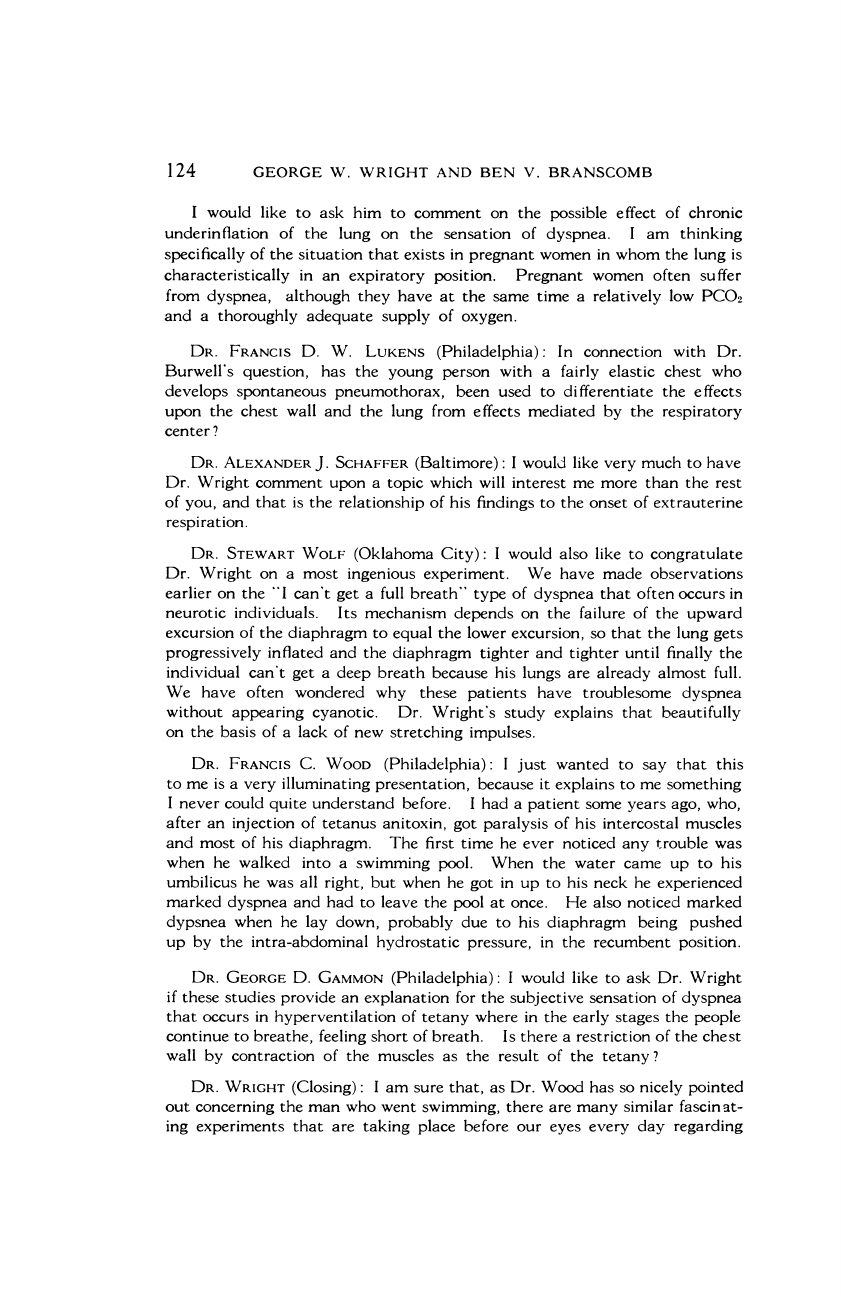
GEORGE
W.
WRIGHT
AND
BEN
V.
BRANSCOMB
I
would
like
to
ask
him
to
comment
on
the
possible
effect
of
chronic
underinflation
of
the
lung
on
the
sensation
of
dyspnea.
I
am
thinking
specifically
of
the
situation
that
exists
in
pregnant
women
in
whom
the
lung
is
characteristically
in
an
expiratory
position.
Pregnant
women
often
suffer
from
dyspnea,
although
they
have
at
the
same
time
a
relatively
low
PCO2
and
a
thoroughly
adequate
supply
of
oxygen.
DR.
FRANCIS
D.
W.
LUKENS
(Philadelphia):
In
connection
with
Dr.
Burwell's
question,
has
the
young
person
with
a
fairly
elastic
chest
who
develops
spontaneous
pneumothorax,
been
used
to
differentiate
the
effects
upon
the
chest
wall
and
the
lung
from
effects
mediated
by
the
respiratory
center?
DR.
ALEXANDER
J.
SCHAFFER
(Baltimore):
I
would
like
very
much
to
have
Dr.
Wright
comment
upon
a
topic
which
will
interest
me
more
than
the
rest
of
you,
and
that
is
the
relationship
of
his
findings
to
the
onset
of
extrauterine
respiration.
DR.
STEWART
WOLF
(Oklahoma
City):
I
would
also
like
to
congratulate
Dr.
Wright
on
a
most
ingenious
experiment.
We
have
made
observations
earlier
on
the
"I
can't
get
a
full
breath"
type
of
dyspnea
that
often
occurs
in
neurotic
individuals.
Its
mechanism
depends
on
the
failure
of
the
upward
excursion
of
the
diaphragm
to
equal
the
lower
excursion,
so
that
the
lung
gets
progressively
inflated
and
the
diaphragm
tighter
and
tighter
until
finally
the
individual
can't
get
a
deep
breath
because
his
lungs
are
already
almost
full.
We
have
often
wondered
why
these
patients
have
troublesome
dyspnea
without
appearing
cyanotic.
Dr.
Wright's
study
explains
that
beautifully
on
the
basis
of
a
lack
of
new
stretching
impulses.
DR.
FRANCIS
C.
WOOD
(Philadelphia):
I
just
wanted
to
say
that
this
to
me
is
a
very
illuminating
presentation,
because
it
explains
to
me
something
I
never
could
quite
understand
before.
I
had
a
patient
some
years
ago,
who,
after
an
injection
of
tetanus
anitoxin,
got
paralysis
of
his
intercostal
muscles
and
most
of
his
diaphragm.
The
first
time
he
ever
noticed
any
trouble
was
when
he
walked
into
a
swimming
pool.
When
the
water
came
up
to
his
umbilicus
he
was
all
right,
but
when
he
got
in
up
to
his
neck
he
experienced
marked
dyspnea
and
had
to
leave
the
pool
at
once.
He
also
noticed
marked
dypsnea
when
he
lay
down,
probably
due
to
his
diaphragm
being
pushed
up
by
the
intra-abdominal
hydrostatic
pressure,
in
the
recumbent
position.
DR.
GEORGE
D.
GAMMON
(Philadelphia):
I
would
like
to
ask
Dr.
Wright
if
these
studies
provide
an
explanation
for
the
subjective
sensation
of
dyspnea
that
occurs
in
hyperventilation
of
tetany
where
in
the
early
stages
the
people
continue
to
breathe,
feeling
short
of
breath.
Is
there
a
restriction
of
the
chest
wall
by
contraction
of
the
muscles
as
the
result
of
the
tetany?
DR.
WRIGHT
(Closing):
I
am
sure
that,
as
Dr.
Wood
has
so
nicely
pointed
out
concerning
the
man
who
went
swimming,
there
are
many
similar
fascinat-
ing
experiments
that
are
taking
place
before
our
eyes
every
day
regarding
124
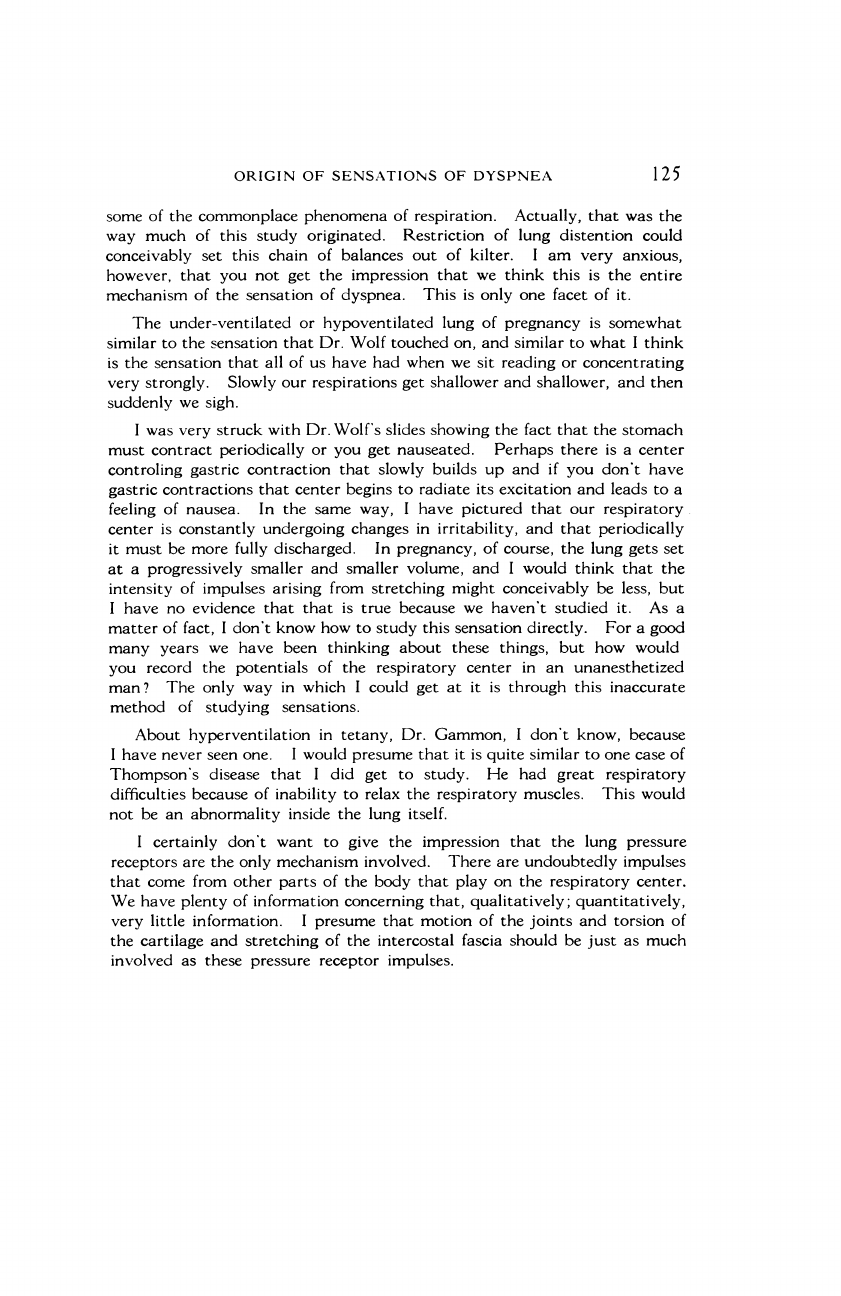
ORIGIN
OF
SENSATIONS
OF
DYSPNEA
some
of
the
commonplace
phenomena
of
respiration.
Actually,
that
was
the
way
much
of
this
study
originated.
Restriction
of
lung
distention
could
conceivably
set
this
chain
of
balances
out
of
kilter.
I
am
very
anxious,
however,
that
you
not
get
the
impression
that
we
think
this
is
the
entire
mechanism
of
the
sensation
of
dyspnea.
This
is
only
one
facet
of
it.
The
under-ventilated
or
hypoventilated
lung
of
pregnancy
is
somewhat
similar
to
the
sensation
that
Dr.
Wolf
touched
on,
and
similar
to
what
I
think
is
the
sensation
that
all
of
us
have
had
when
we
sit
reading
or
concentrating
very
strongly.
Slowly
our
respirations
get
shallower
and
shallower,
and
then
suddenly
we
sigh.
I
was
very
struck
with
Dr.
Wolf's
slides
showing
the
fact
that
the
stomach
must
contract
periodically
or
you
get
nauseated.
Perhaps
there
is
a
center
controling
gastric
contraction
that
slowly
builds
up
and
if
you
don't
have
gastric
contractions
that
center
begins
to
radiate
its
excitation
and
leads
to
a
feeling
of
nausea.
In
the
same
way,
I
have
pictured
that
our
respiratory
center
is
constantly
undergoing
changes
in
irritability,
and
that
periodically
it
must
be
more
fully
discharged.
In
pregnancy,
of
course,
the
lung
gets
set
at
a
progressively
smaller
and
smaller
volume,
and
I
would
think
that
the
intensity
of
impulses
arising
from
stretching
might
conceivably
be
less,
but
I
have
no
evidence
that
that
is
true
because
we
haven't
studied
it.
As
a
matter
of
fact,
I
don't
know
how
to
study
this
sensation
directly.
For
a
good
many
years
we
have
been
thinking
about
these
things,
but
how
would
you
record
the
potentials
of
the
respiratory
center
in
an
unanesthetized
man?
The
only
way
in
which
I
could
get
at
it
is
through
this
inaccurate
method
of
studying
sensations.
About
hyperventilation
in
tetany,
Dr.
Gammon,
I
don't
know,
because
I
have
never
seen
one.
I
would
presume
that
it
is
quite
similar
to
one
case
of
Thompson's
disease
that
I
did
get
to
study.
He
had
great
respiratory
difficulties
because
of
inability
to
relax
the
respiratory
muscles.
This
would
not
be
an
abnormality
inside
the
lung
itself.
I
certainly
don't
want
to
give
the
impression
that
the
lung
pressure
receptors
are
the
only
mechanism
involved.
There
are
undoubtedly
impulses
that
come
from
other
parts
of
the
body
that
play
on
the
respiratory
center.
We
have
plenty
of
information
concerning
that,
qualitatively;
quantitatively,
very
little
information.
I
presume
that
motion
of
the
joints
and
torsion
of
the
cartilage
and
stretching
of
the
intercostal
fascia
should
be
just
as
much
involved
as
these
pressure
receptor
impulses.
1
25
